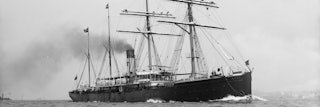The “New World” as America was called, offered many opportunities for trade and livelihood improvement. Jacobus Cools from Sluis, Zeeland Flanders, also left. His destination was the city of Kalamazoo in Michigan, United States. What did he take with him?
The emigration of Dutch people only started well in the 19th century. Also Zeeland people, especially farm workers and religious detainees, went to the New World in the hope of more prosperity and equal treatment for those who think differently. Until 1940, the Zeelanders were even leaders.
At least fifteen percent of all Dutch emigrants between 1840 and 1940 came from Zeeland. That is no less than 32,000 people in Zeeland. Migrants left their province in large numbers after a preacher and a rich farmer organized the emigration from Goes and Borssele in 1847. Many Zeelanders ended up in wooded Michigan and founded the villages of Holland and Zeeland.
Blacksmith from Sluis
Jacobus Cools from Sluis, Zeeuws-Vlaanderen, left for America at the end of 1891 on board the steamship Rhynland of the Belgian company Red Star Line. The ship was destined for Jersey City in the state of New Jersey. From there Cools would travel further to New York, where he wanted to take the train to Kalamazoo in the state of Michigan. One of his brothers already lived in the USA.

The 49-year-old Cools, born on July 4, 1842 in Sluis, Zeeuws-Vlaanderen, was single. He was a blacksmith by profession and would not have had much income, because he emigrated out of a “desire for improvement”. He was not the only one. Another eight workers consisting of six men and two women left Sluis in 1891 for the same reason. The tenth emigrant was a merchant, he left the country due to debts.
Cools didn’t leave much family behind. His parents were both deceased. His parents Karel Johannes Cools and Maria Theresia Versnick were workers, or as his birth certificate stated: workman and workwoman. Later his father would be registered as a bread baker. Jacobus had two brothers and a sister, Johannes, Franciscus Bernardus and Amelia. The brothers had previously emigrated, although the latter had returned and had founded a family in Aardenburg. His sister was also married and lived in Axel.
An emigrant’s luggage
What did an emigrant bring to the New World? Jacobus Cools took the following with him:

“In a blue linen bag:a leather apron,
- a vest,
- a opened box of cigars,
- a belt,
- a jacket,
- two knit caps,
- two hats,
- a pair of boots,
- a roll of linen,
- a pack of tobacco,
- a bag of blue fabric,
- four handkerchiefs,
- a tobacco bag,
- a pair of woolen gloves,
- three socks,
- a wallet with three keys and a watch chain,
- two boxes of bare iron,
- a porcelain pot,
- a used meerschaum pipe bowl,
- a case with matches.
In a wallet:
- a money order worth fifty francs,
- a patent,
- two photos,
- a reservation for the train from New York to Kalamazoo,
- a workers’ booklet with former employers,
- a removal message and two letters.
A pair of clogs and an umbrella.”
That we know this is the result of his early death.
The steamer Rhynland from Antwerp arrived on January 2, 1892 in Ellis Island, New York. The day before the new immigration center had opened there. The New York Passenger Arrival Lists (Ellis Island) announces the arrival of Jacobus Cools and mentions his profession: blacksmith. Yet Cools would never set foot in America. He died on board. The first and second officer of the steamer made the inventory of his posessions on January 3.

Back in Zeeland
At the end of January the Ministry of Foreign Affairs informed the Queen’s Commissioner (CdK) in Zeeland of the death of Cools. Was informed about the heirs. The CdK received a response from the mayor of Sluis: Jacobus Cools had two brothers, one of whom in America, and one sister.
The belongings of Cools were sent from America to the mayor of Sluis for delivery to his brother Franciscus Bernardus Cools. The latter did not immediately receive the goods, the mayor reported to the CdK in March 1892 because “the interested party initially did not intend to pay the advanced freight charges of f 2.64 guilders”. It must have been a considerable amount for him. The blue linen bag was received in May 1892.
